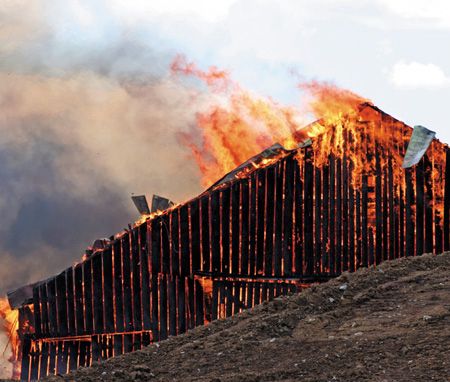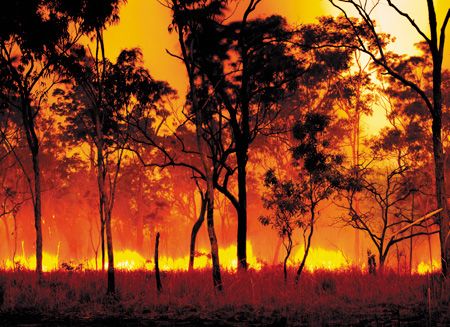Prevent barn fires to preserve horses' lives
Equine veterinarians have a unique opportunity to work with barn personnel to protect horses from all-too-common disaster.

Getty ImagesBarn fires are one of the primary causes of disaster-related horse deaths in the United States, says Ron Lindroth, chief of the Central Valley Fire District in Belgrade, Montana. Knowing this, equine veterinarians can partner with fire service personnel and barn managers to reduce the loss of life and property. Often veterinarians have access to horse facilities that fire departments do not, and they may be able to spot potential problems to help prevent fires from occurring in the first place. Here are some key considerations.
Prevention is key
Once a fire starts in a barn, it's extremely difficult to put out. A barn is large and airy and typically contains a high volume of exposed combustibles, allowing a fire to engulf the barn quickly. Plus, horse barns are usually located in remote areas far from fire stations, so emergency response times can be long. Potential severity of horse burn injury is high (see this article fom the April 2013 issue); human injury and loss of life are also a major concern.
Know what causes fires. According to the National Fire Protection Association (NFPA), the number-one source of fire in horse barns is improperly used or faulty heating equipment, which represents 23 percent of barn fires. Heat lamps are the most common cause of these types of fires fires. Together, heating equipment, electrical distribution (faulty wiring) and lighting equipment cause 40 percent of barn fires.
“People who keep their horses in barns need to make sure the heating and electrical equipment are installed correctly, in good repair, installed within conduits when subject to damage, and connected to ground-fault interrupters,” Lindroth says. Heat lamps should be of good quality and secured in a location where the horse can't knock them over into bedding. Combustible material should be stored far from heat-producing lights or equipment. Needless to say, poorly maintained or makeshift heat sources should never be used.
About 8 percent of barn fires are “exposure” fires, according to the NFPA. A large portion of these result from burning ditches, fence rows or other material too close to the barn.
Post clear messaging. Barn managers need to clearly post and strictly enforce smoking bans in barns. Additionally, they should post highly visible notices in several locations instructing personnel how to call for emergency services by dialing 911. It's a good idea to include the name and address of the facility right on the sign in case it's a visitor with a cell phone who calls-or an agitated staff member who's not thinking clearly. Exits, evacuation routes and safe areas should also be clearly marked.
Evaluate storage. Another important fire prevention strategy is to store hay, feed, manure and bedding material-all combustible items-in a different building. “If the materials catch on fire due to spontaneous combustion, or from an electrical or heat source being too close, with them stored properly away from the barn, the barn and animals are at reduced risk of loss,” Lindroth says.
Know your alarms. In barns, smoke detectors are generally not good for detecting fires. Barns have such a dusty environment that smoke detectors can be damaged and activate false alarms. Rate-of-rise heat detectors, while more expensive, are not affected by dust like smoke detectors are. Plus, fire detection systems are an advantage only if they notify someone 24 hours a day. Facilities managers should consider having the fire alarm transmit to an alarm monitoring company so the fire department will automatically be notified.
Install sprinklers or fire extinguishers. Lindroth strongly suggests that high-value horse facilities have a fire sprinkler system installed-they're the best approach to protecting property and horses from a serious barn fire. Even in larger, well-built stud farm barns with stone or granite exteriors, oak or hardwood stalls and significant solid structure, a fire sprinkler system is a good investment. “Whether it's the high-end value of the animals or a high-value facility, the gold standard is a fire sprinkler system,” Lindroth says.
If sprinklers are not an economically viable option, make sure several 20-lb ABC (multipurpose) fire extinguishers are available to fight small fires if they erupt. Extinguishers should be inspected annually to ensure they're properly charged and usable, and barn personnel should be trained to use them correctly. It's also a good idea to have garden hoses and nozzles handy. “All these items are critical to fight fires when they're small, such as trash-can-size fires,” Lindroth says.
However, once a fire is larger than a trash can, it becomes much more difficult for untrained individuals to control it. “Fire essentially doubles in size every minute,” Lindroth says. “It grows logarithmically-what was first two square feet becomes four, then eight, then 16 and so on. Since a fire can get out of control so quickly, calling 911 to notify the fire department immediately is essential.”
Even with a small fire, it's best call the fire department anyway-as early as possible-so officers can check to make sure the fire is truly out and won't rekindle at a later time.
Evacuating horses
Just as firefighters recommend that people have two escape routes out of every room in a house, they also advise two escape routes from a barn stall, Lindroth says. For a center-hallway type of barn, that means an exterior door in each stall. “When a fire begins, it's safer to open exterior stall doors,” Lindroth says. “To try to evacuate horses from a center hallway is a very dangerous proposition-not a good idea.”
Evacuation should begin as soon as 911 has been called. The first horses evacuated should be those farthest from the fire, Lindroth says-it's better to focus on the horses at the perimeter than to risk getting too close to a major blaze. “The barn, horses and those items already affected might have to be sacrificed for other animals and personnel to remain safe,” Lindroth says. “The fire department, once it arrives, will determine the best course of action to take to save the most lives and property possible. We always contend that human life is more valuable than animal life. Though we acknowledge owners love their animals, it's not worth the risk to anybody's life.”
The decision of whether to stay and defend the facility and horses or evacuate early is one to be made well before a fire occurs. To stay and defend, you need adequate defensible space, training on how to keep yourself safe and some tools available to fight the fire. Without any one of these, the best option is to evacuate early. If you decide to evacuate, have a good plan. Trucks and trailers that are serviceable, easily accessible, gassed up and ready to go are as important as having horses that will easily load and a safe shelter to head to.
Consideration for wildfires
Not all areas of the country are susceptible to wildfires; however, if a facility is located in a rural area or natural vegetation is prevalent, there's a good chance it's at risk. “It's important to clear vegetation a sufficient distance away from the barn,” cautions Lindroth. “Keep the weeds and grasses mowed back, and if at all possible have at least a two-foot-wide strip of noncombustible material-gravel, dirt or a driveway-encircling the barn.”

Getty ImagesIf a grass or brush fire starts nearby, a clear area can provide a safety area for horses and keep the barn from catching fire, Lindroth continues. A good rule of thumb is horizontal clearance that's 10 times the height of the surrounding natural vegetation. “Having adequate defensible space from wildfire is a wise prevention measure,” Lindroth says.
In the case of a wildfire, traffic heading out of the area could be significant, Lindroth says-meaning evacuation should begin well ahead of immediate danger. “A road or highway could be blocked by others trying to escape a raging wildfire or emergency equipment attempting to access the fire area,” he says. “If you plan to evacuate, do so early and well ahead of the fire. Due to wind changes, variable terrain and the fuels involved, the possibility of a major wildfire moving quickly and trapping you is a very real danger. Statistically, your greatest chance of dying is evacuating at the last minute.”
Summary: Know, plan, be conscious of the risk
Fires are extremely dangerous and represent a significant risk to horse barns, horses and human life. Putting a proper plan in place to mitigate the risk of fire, as well as having the proper equipment and knowledge of what to do in case of a fire, is crucial for everyone working in this environment. Veterinarians have a wonderful opportunity to be a partner in fire prevention efforts that will not only save property but the lives of hundreds of horses each year.
Suggested Reading
1. Lindroth R. “Emergency preparedness: A Fire Chief's perspective.” AAEP Proceedings, December 2014, 60:451.
2. “Structure Fire in Barns,” National Fire Protection Association (NFPA) 2012, www.nfpa.org/research/reports-and-statistics/fires-by-property-type/storage/barns.
3. “Wildfire Preparedness,” NFPA 2014, www.firewise.org/wildfire-preparedness.aspx.